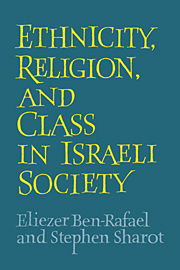Book contents
- Frontmatter
- Contents
- Acknowledgments
- I Theoretical and empirical background
- 1 Ethnicity and society
- 2 Divisions in Israeli society
- 3 Theoretical perspectives in Israeli sociology
- 4 The sample, its background, and its setting
- II Social patterns and behavior
- III Identities and images
- IV The impact of stratification
- V Social cleavages: an overview of Israeli society and some theoretical implications
- Appendix A The sample
- Appendix B Deprivation index
- Appendix C Indexes of ethnic identification
- Glossary
- Notes
- References
- Index
4 - The sample, its background, and its setting
Published online by Cambridge University Press: 12 September 2009
- Frontmatter
- Contents
- Acknowledgments
- I Theoretical and empirical background
- 1 Ethnicity and society
- 2 Divisions in Israeli society
- 3 Theoretical perspectives in Israeli sociology
- 4 The sample, its background, and its setting
- II Social patterns and behavior
- III Identities and images
- IV The impact of stratification
- V Social cleavages: an overview of Israeli society and some theoretical implications
- Appendix A The sample
- Appendix B Deprivation index
- Appendix C Indexes of ethnic identification
- Glossary
- Notes
- References
- Index
Summary
Ethnicity, class, and religiosity are investigated in this study, both as cleavages with their own particular characteristics and as cleavages that interact and influence each other. In our analysis of ethnicity, which is the most central topic of this study, we attempt to overcome some of the limitations of previous empirical studies that have made a broad distinction between “Ashkenazim” and “Orientals” and then focused primarily on the latter, especially those in the lower strata. European Israelis and middle-class Middle Easterners have rarely been the object of research. We decided on a sample of four specific groups of origin, two European and two Middle Eastern, that are demographically important and, in terms of their socio-economic profiles and cultural characteristics, are broadly representative of the wide spectrum of Jewish groups of origin in Israel. The socio-economic distribution of the sample was structured to enable us to investigate both the effect of socio-economic status on ethnicity and the importance of classes as a separate hierarchy from that of ethnic groups. The sample was not structured for religiosity, but the means by which lists of respondents were drawn up, from the fathers of children in both secular and religious schools, provided a representative range of levels of religiosity among Israeli Jews.
- Type
- Chapter
- Information
- Ethnicity, Religion and Class in Israeli Society , pp. 54 - 72Publisher: Cambridge University PressPrint publication year: 1991



